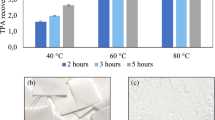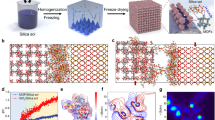Abstract
Recent world events have emphasized the need to develop innovative, functional materials that will safely neutralize chemical warfare (CW) agents in situ to protect military personnel and civilians from dermal exposure. Here, we demonstrate the efficacy of a novel, proof-of-concept design for a Cu-containing catalyst, chemically bonded to a single-wall carbon nanotube (SWCNT) structural support, to effectively degrade an organophosphate simulant. SWCNTs have high tensile strength and are flexible and light-weight, which make them a desirable structural component for unique, fabric-like materials. This study aims to develop a self-decontaminating, carbon nanotube-derived material that can ultimately be incorporated into a wearable fabric or protective material to minimize dermal exposure to organophosphate nerve agents and to prevent accidental exposure during decontamination procedures. Carboxylated SWCNTs were functionalized with a polymer, which contained Cu-chelating bipyridine groups, and their catalytic activity against an organophosphate simulant was measured over time. The catalytically active, functionalized nanomaterial was characterized using X-ray fluorescence and Raman spectroscopy. Assuming zeroth-order reaction kinetics, the hydrolysis rate of the organophosphate simulant, as monitored by UV-vis absorption in the presence of the catalytically active nanomaterial, was 63 times faster than the uncatalyzed hydrolysis rate for a sample containing only carboxylated SWCNTs or a control sample containing no added nanotube materials.

Similar content being viewed by others
References
Persian Gulf War Illness Task Force. Khamisiyah: A Historical Perspective on Related Intelligence [Online]. Persian Gulf War Illness Task Force; http://www.gulflink.osd.mil/cia_wp/ (accessed Aug 16, 2012).
Russell, A. J.; Berberich, J. A.; Drevon, G. F.; Koepsel, R. R. Biomaterials for mediation of chemical and biological warfare agents. Annu. Rev. Biomed. Eng. 2003, 5, 1–27.
Munro, N. B.; Watson, A. P.; Ambrose, K. R.; Griffin, G. D. Treating exposure to chemical warfare agents: Implications for health care providers and community emergency planning. Environ. Health Perspect. 1990, 89, 205–215.
Reutter, S. Hazards of chemical weapons release during war: New perspectives. Environ. Health Perspect. 1999, 107, 985–990.
Brown, M. A.; Brix, K. A. Review of health consequences from high-, intermediate- and low-level exposure to organophosphorus nerve agents. J. Appl. Toxicol. 1998, 18, 393–408.
Army Medical Department Center and School. Multiservice Tactics, Techniques, and Procedures for Treatment of Chemical Agent Casualties and Conventional Military Chemical Injuries. Departments of the Army, The Navy, and the Air Force and the Commandant of the Marine Corps: Fort Sam Houston, TX, 2007.
Amitai, G.; Murata, H.; Andersen, J. D.; Koepsel, R. R.; Russell, A. J. Decontamination of chemical and biological warfare agents with a single multi-functional material. Biomaterials 2010, 31, 4417–4425.
Hight Walker, A. R.; Suenram, R. D.; Samuels, A.; Jensen, J.; Ellzy, M. W.; Lochner, J. M.; Zeroka, D. Rotational spectrum of Sarin. J. Mol. Spectrosc. 2001, 207, 77–82.
Erdem, M.; Say, R.; Ersöz, A.; Denizli, A.; Türk, H. Biomimicking, metal-chelating and surface-imprinted polymers for the degradation of pesticides. React. Funct. Polym. 2010, 70, 238–243.
Hartshorn, C. M.; Singh, A.; Chang, E. L. Metal-chelator polymers as organophosphate hydrolysis catalysts. J. Mater. Chem. 2002, 12, 602–605.
Wagner, G. W.; Bartram, P. W.; Koper, O.; Klabunde, K. J. Reactions of VX, GD, and HD with nanosize MgO. J. Phys. Chem. B 1999, 103, 3225–3228.
Wagner, G. W.; Koper, O. B.; Lucas, E.; Decker, S.; Klabunde, K. J. Reactions of VX, GD, and HD with nanosize CaO: Autocatalytic dehydrohalogenation of HD. J. Phys. Chem. B 2000, 104, 5118–5123.
Wagner, G. W.; Procell, L. R.; O’Connor, R. J.; Munavalli, S.; Carnes, C. L.; Kapoor, P. N.; Klabunde, K. J. Reactions of VX, GB, GD, and HD with nanosize Al2O3. Formation of aluminophosphonates. J. Am. Chem. Soc. 2001, 123, 1636–1644.
Badawi, A. M.; Hafiz, A. A.; Ibrahim, H. A. Catalytic destruction of malathion by metallornicelle layers. J. Surfactants Deterg. 2003, 6, 239–241.
Gill, I.; Ballesteros, A. Degradation of organophosphorous nerve agents by enzyme-polymer nanocomposites: Efficient biocatalytic materials for personal protection and large-scale detoxification. Biotechnol Bioeng 2000, 70, 400–410.
Popiel, S.; Nawala, J.; Sankowska, M.; Witkiewicz, Z.; Bernat, P. Enzymes as catalysts of decomposition of chemical warfare agents. Przem. Chem. 2010, 89, 1361–1369.
Yang, F. X.; Wild, J. R.; Russell, A. J. Nonaqueous biocatalytic degradation of a nerve-gas mimic. Biotechnol. Prog. 1995, 11, 471–474.
Sharma, S. P.; Tomar, L. N. S.; Acharya, J.; Chaturvedi, A.; Suryanarayan, M. V. S.; Jain, R. Acetylcholinesterase inhibition-based biosensor for amperometric detection of Sarin using single-walled carbon nanotube-modified ferrule graphite electrode. Sens. Actuaters B-Chem. 2012, 166, 616–623.
Wei, Y.; Liu, Z. G.; Gao, C.; Wang, L.; Liu, J. H.; Huang, X. J. Electrochemical sensors and biosensors based on nanomaterials: A new approach for detection of organic micropollutants. Prog. Chem. 2012, 24, 616–627.
Zeng, Y.; Yu, D.; Yu, Y.; Zhou, T.; Shi, G. Differential pulse voltammetric determination of methyl parathion based on multiwalled carbon nanotubes-poly(acrylamide) nanocomposite film modified electrode. J. Hazard. Mater. 2012, 217, 315–322.
Sharma, P. K.; Gupta, G.; Nigam, A. K.; Pandey, P.; Boopathi, M.; Ganesan, K.; Singh, B. Photoelectrocatalytic degradation of blistering agent sulfur mustard to non-blistering substances using pPy/NiOBPC nanocomposite. J. Mol. Catal. A: Chem. 2013, 366, 368–374.
Grandcolas, M.; Louvet, A.; Keller, N.; Keller, V. Layer-by-layer deposited titanate-based nanotubes for solar photocatalytic removal of chemical warfare agents from textiles. Angew. Chem. Int. Edit. 2009, 48, 161–164.
Ghemes, A.; Minami, Y.; Muramatsu, J.; Okada, M.; Mimura, H.; Inoue, Y. Fabrication and mechanical properties of carbon nanotube yarns spun from ultra-long multi-walled carbon nanotube arrays. Carbon 2012, 50, 4579–4587.
Miao, M. H. Production, structure and properties of twistless carbon nanotube yarns with a high density sheath. Carbon 2012, 50, 4973–4983.
Steiner, S.; Busato, S.; Ermanni, P. Mechanical properties and morphology of papers prepared from single-walled carbon nanotubes functionalized with aromatic amides. Carbon 2012, 50, 1713–1719.
Decker, J. E.; Hight Walker, A. R.; Bosnick, K.; Clifford, C. A.; Dai, L.; Fagan, J.; Hooker, S.; Jakubek, Z. J.; Kingston, C.; Makar, J. et al. Sample preparation protocols for realization of reproducible characterization of single-wall carbon nanotubes. Metrologia 2009, 46, 682–692.
Ritchie, N. DTSA-II [Online]. National Institute of Standards and Technology (NIST); Retrieved from the Public Domain Software from NIST: http://www.cstl.nist.gov/div837/837.02/index.html (accessed Oct 24, 2012).
Ramaseshan, R.; Sundarrajan, S.; Liu, Y. J.; Barhate, R. S.; Lala, N. L.; Ramakrishna, S. Functionalized polymer nanofibre membranes for protection from chemical warfare stimulants. Nanotechnology 2006, 17, 2947–2953.
Author information
Authors and Affiliations
Corresponding authors
Electronic supplementary material
Rights and permissions
About this article
Cite this article
Bailey, M.M., Heddleston, J.M., Davis, J. et al. Functionalized, carbon nanotube material for the catalytic degradation of organophosphate nerve agents. Nano Res. 7, 390–398 (2014). https://doi.org/10.1007/s12274-014-0405-3
Received:
Revised:
Accepted:
Published:
Issue Date:
DOI: https://doi.org/10.1007/s12274-014-0405-3




